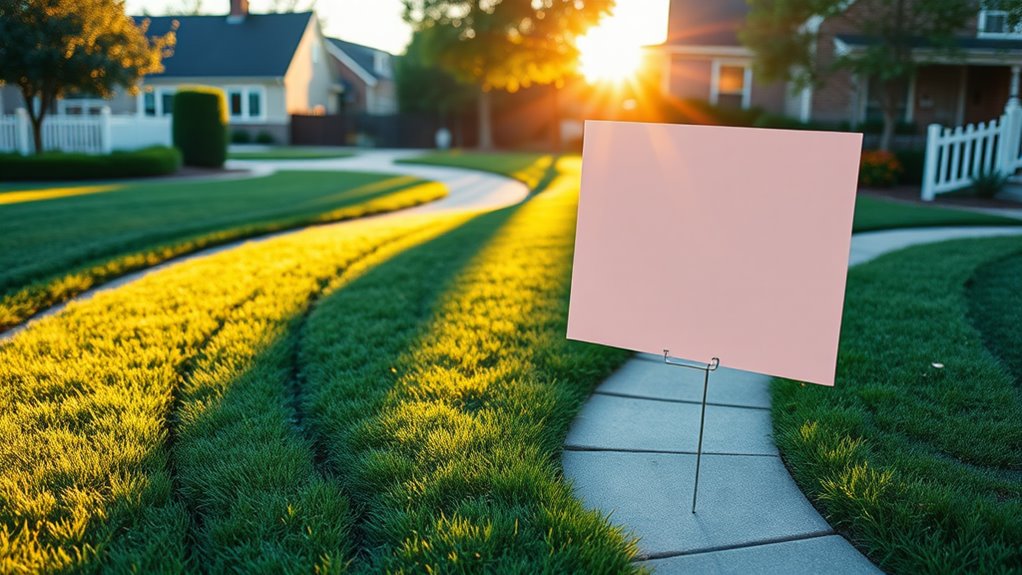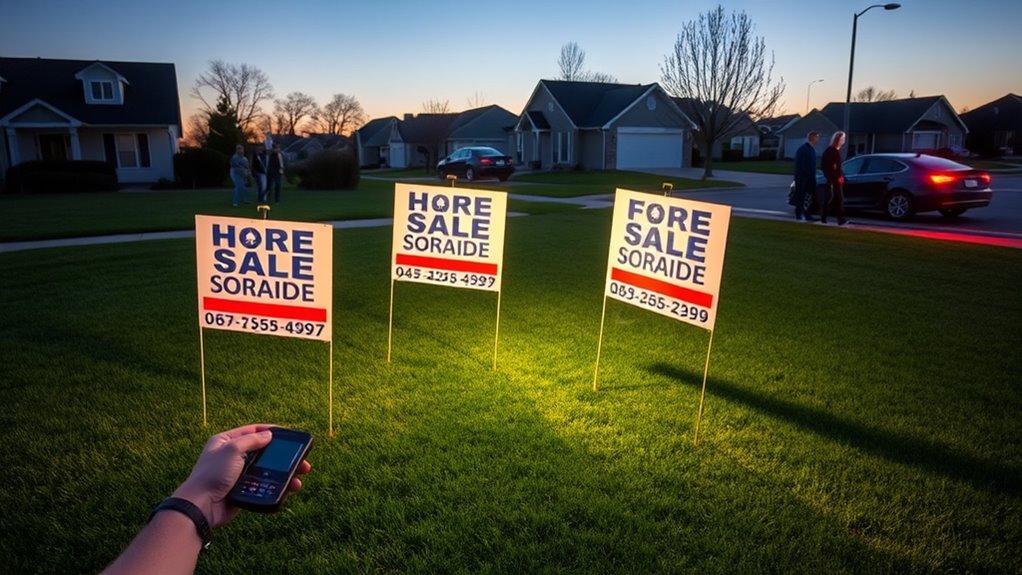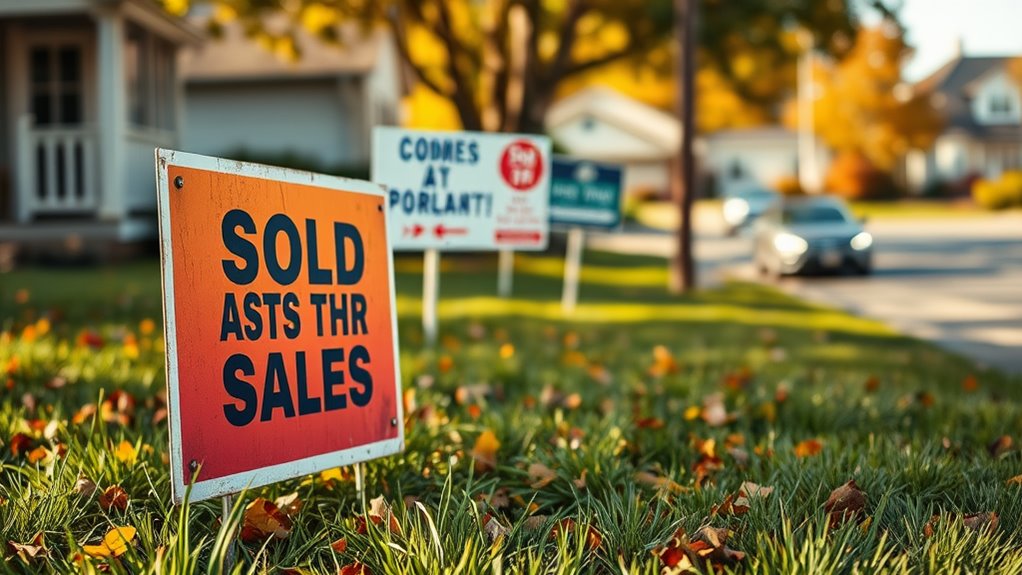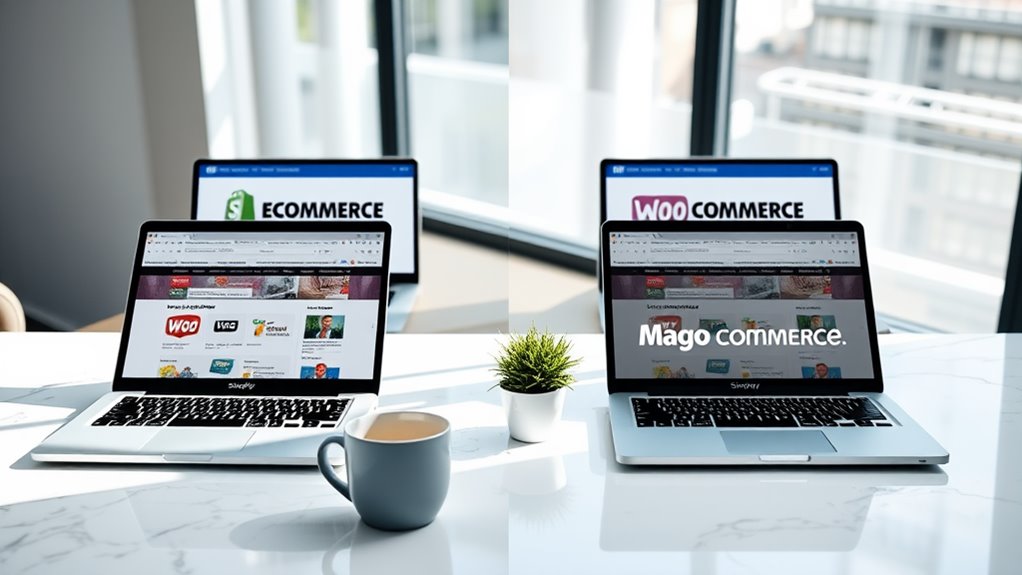Yard signs offer one of the most cost-effective ways to advertise your business locally, with impressions costing as little as $0.002 per view over a 90-day period. You'll benefit from 24/7 visibility when you place signs in high-traffic areas like busy intersections, shopping centers, and school zones. While initial costs range from $5-15 per sign, their durability lets you reuse them for multiple campaigns, maximizing your investment. To succeed, you'll need high-contrast designs with clear, readable text visible from 50+ feet away, and you must comply with local placement regulations. Understanding proper placement strategy and design principles will help reveal your signs' full marketing potential.
Key Takeaway
- Yard signs offer one of the lowest costs per impression at $0.002 over 90 days, making them highly cost-effective for local advertising.
- High-traffic placement locations near intersections, shopping centers, and schools maximize visibility and marketing reach for businesses.
- Signs with proper design elements like high contrast and limited text can effectively capture attention from up to 50 feet away.
- Reusability and durability of 6-24 months provide extended advertising value, especially when signs are properly maintained and stored.
- Measurable marketing impact through tracking methods like unique phone numbers and QR codes helps validate advertising effectiveness.
The Cost-Benefit Analysis
A cost-benefit analysis of yard signs reveals impressive returns on investment compared to other advertising methods. You'll find that the initial investment for a basic corrugated plastic sign typically ranges from $5-15 per unit, with bulk orders reducing your per-sign cost greatly.
Key Financial Benefits:
- Cost per impression: As low as $0.002 per view over a 90-day period
- Durability: Most signs last 6-24 months with proper care
- Reusability: You can repurpose signs for multiple campaigns
Calculating Your ROI:
Consider these metrics when evaluating yard sign effectiveness:
- Average daily traffic exposure (500-2,000 views per busy location)
- Conversion rate (typically 0.5-2% for local businesses)
- Customer lifetime value impact
You'll need to factor in these additional considerations:
- Installation costs ($2-5 per sign)
- Maintenance and replacement expenses
- Local ordinance compliance fees
- Weather-related damages
For maximum cost efficiency, you should:
- Target high-traffic intersections
- Rotate locations every 2-3 weeks
- Track response rates using unique QR codes or landing pages
- Monitor sign condition and replace damaged units promptly
Where Yard Signs Work Best
Strategic placement of yard signs can make or break your advertising campaign's success. You'll want to focus on high-traffic areas where your target audience naturally congregates or passes through during their daily routines.
Most Effective Locations:
- Busy intersections with traffic lights, where drivers have time to read
- Near shopping centers and strip malls, especially during peak hours
- Adjacent to schools during drop-off and pick-up times
- Around recreational facilities and parks
- Near residential developments under construction
Key Placement Considerations:
- Position signs at eye level, approximately 4-5 feet from the ground
- Maintain 15-20 feet distance from roadways for ideal visibility
- Install at 45-degree angles to maximize viewing from multiple directions
- Group signs strategically (3-4 maximum) at major decision points
You'll find the greatest impact in areas where traffic naturally slows down, giving viewers time to absorb your message. Research shows that signs placed near traffic signals receive up to 40% more attention than those in continuous-flow areas. Remember to check local regulations, as many municipalities have specific rules about sign placement and duration.
Design Elements That Drive Results

While finding the right location sets the foundation for your yard sign campaign, effective design elements turn passing glances into meaningful engagement. Your design strategy must prioritize visibility and quick comprehension, as viewers typically have just 3-5 seconds to process your message.
Key Design Elements for Maximum Impact:
- Contrast: Use color combinations with at least 70% contrast ratio (e.g., black on yellow, blue on white)
- Typography: Select fonts that are readable from 50+ feet away, keeping text height at minimum 3 inches
- Message Structure: Limit content to 7 words or less, focusing on your primary call-to-action
- White Space: Maintain 30% empty space to prevent visual crowding
Layout Hierarchy:
- Headline (largest text): Your main benefit or service
- Supporting Info (medium text): Key differentiator or special offer
- Contact Method (smaller text): Phone number or website
You'll want to incorporate your brand colors when possible, but don't let branding override visibility. If your corporate colors don't provide sufficient contrast, create a yard sign-specific color scheme that maintains brand recognition while ensuring readability.
Legal Guidelines and Local Regulations
Every municipality enforces distinct rules governing yard sign placement and usage, making compliance research essential before launching your campaign. You'll need to verify local ordinances regarding size restrictions, setback requirements, and duration limits to avoid potential fines or sign removal.
Common regulations you'll encounter include:
- Placement restrictions requiring signs to be at least 10 feet from roadways and public sidewalks
- Time limitations that restrict political signs to 60-90 days before elections
- Size constraints typically capping signs at 6-8 square feet for residential areas
Before installing your yard signs, you'll need to contact your local zoning office or municipal authority to obtain necessary permits. Many jurisdictions require written permission and may charge nominal fees for commercial signage. You'll also want to verify whether your property falls within homeowners' association guidelines, as these often impose additional restrictions.
Keep detailed records of your sign permits and placement locations. If you're planning a multi-area campaign, create a spreadsheet tracking different jurisdictional requirements, as regulations can vary considerably between neighboring towns. Remember that regulations may change seasonally or during special events.
Measuring Your Sign's Marketing Impact

Once you've navigated the legal requirements, tracking your yard signs' effectiveness becomes your next priority. You'll need to implement specific tracking methods to measure your return on investment and optimize your signage strategy.
Key Performance Metrics to Monitor:
- Track incoming calls or website visits using unique phone numbers or URLs
- Monitor foot traffic increases during sign placement periods
- Calculate conversion rates from sign viewers to customers
- Document the number of direct inquiries mentioning your signs
Implementation Methods:
- Create QR codes linking to landing pages with tracking capabilities
- Use call tracking software to monitor sign-specific phone numbers
- Implement customer surveys asking how they found your business
- Record sign locations and correlate them with sales data
To maximize your tracking efficiency, establish a baseline of business activity before deploying signs, then measure changes across 30, 60, and 90-day intervals. You'll want to document weather conditions, seasonal variations, and competing advertisements in your target areas. Consider using A/B testing with different sign designs or locations to determine which combinations generate the highest response rates.
Remember to adjust your strategy based on collected data, removing underperforming signs and reinforcing successful locations with additional marketing support.
Conclusion
You'll find yard signs can be an effective piece of your marketing mix when you've got clear goals and understand your local market. Consider how Tim's Home Services increased their spring bookings by 32% using strategically placed yard signs in high-traffic neighborhoods. Whether you're promoting your business or event, remember to check local regulations, create eye-catching designs, and track your results to maximize your investment in this tried-and-true advertising method.









